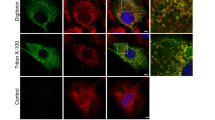Abstract
Phospholipid and neutral lipid composition was studied in the course of myogenic differentiation of the clonal cell line BC3H-1. Total phospholipid content increased during differentiation, predominantly in the major classes of choline and ethanolamine glycerophospholipids. The contents of other lipids, such as triacylglycerols, diminished more than 50% during this period. The content and distribution of fatty acids also underwent marked differentiation-dependent changes. The polyunsaturated (tetrapenta- and hexaenoic) fatty acid species of several phospholipid classes diminished during differentiation, especially those in choline, serine and inositol glycerophospholipids. Most noticeable were the changes in phosphatidylserine; long-chain fatty acids having 20 to 22 carbon atoms and 4 to 6 double bonds decreased from about 30 to about 10 mol%. Although increased levels of saturation in other phospholipid fatty acyl chains appear to accompany the myogenic changes of BC3H-1 cells, some unsaturated fatty acids, such as oleic acid (18∶1), increased by as much as 80% during the same period, suggesting the activation of a Δ9 desaturase. Sphingomyelin contained only saturated and monoenoic fatty acids and exhibited a four- to five-fold decrease in its content of monoenoic acyl groups. Diacylglycerols became enriched in arachidonate and docosahexaenoate. The amount of cholesterol and its esters increased slightly during differentiation of BC3H-1 cells. The data show that several metabolic pathways change during myogenic differentiation of the BC3H-1 clonal cell line, particularlyde novo biosynthetic pathways, elongation/desaturation reactions, and acyl chain turnover. As a consequence of this, the lipid composition of the myoblast form of the BC3H-1 cell, in which the nicotinic acetylcholine receptor and other cell surface receptors are expressed, is thus different from that of the nondifferentiated cell.
Similar content being viewed by others
Abbreviations
- AChR:
-
acetylcholine receptor
- DMA:
-
dimethylacetals
- FFA:
-
free fatty acid
- PA:
-
phosphatidic acid
- PC:
-
phosphatidylcholine
- PE:
-
phosphatidylethanolamine
- PI:
-
phosphatidylinositol
- PS:
-
phosphatidylserine
- PS+CDP-DAG:
-
phosphatidylserine plus cytidine diphosphate-diacylglycerol
- PPI:
-
polyphosphoinositides
- Sph:
-
sphingomyelin
- TAG:
-
triacylglycerol
- TLC:
-
thin-layer chromatography
References
Changeux, J.P. (1990)Trends Pharmacol. Sci. 11, 485–492.
Barrantes, F.J. (1986) inIon Channels in Cells and Model System. (Latorre, R., ed.) pp. 385–400, Plenum Publishing Co., New York.
Barrantes, F.J. (1989)Crit. Rev. Biochem. Molec. Biol. 24, 437–478.
Criado, M., Eibl, H., and Barrantes, F.J. (1982)Biochemistry 21, 3622–3629.
Criado, M., Eibl, H., and Barrantes, F.J. (1984)J. Biol. Chem. 259, 9188–9198.
Jones, O.T., Eubanks, J.H., Earnest, J.P., and McNamee, M.G. (1988)Biochemistry 27, 3733–3742.
Schubert, D., Harris, A., Devine, C.E., and Heinemann, S. (1974)J. Cell. Biol. 61, 398–413.
Patrick, J.J., McMillan, H., Wolfson, H., and O'Brien, J.C. (1977)J. Biol. Chem. 252, 2143–2153.
Folch, J., Lees, M., and Sloane-Stanley, G.H. (1957)J. Biol. Chem. 226, 497–509.
Uma, S., and Ramakrishnan, C.V. (1984)J. Neurochem. 40, 914–916.
Hauser, G., and Eichberg, J. (1973)Biochim. Biophys. Acta 326, 201–209.
Rouser, G.G., Fleischer, S., and Yamamoto, A. (1970)Lipids 5, 494–496.
Pediconi, M.F., Donoso, P., Hidalgo, C., and Barrantes, F.J. (1987)Biochim. Biophys. Acta 921, 398–404.
Shaik, N.A., and Palmer, F.B.S.C. (1977)J. Neurochem. 28, 395–402.
Morrison, W.R., and Smith, L.M. (1964)J. Lipid Res. 5, 600–608.
Lowry, O.H., Rosebrough, N.J., Farr, A.L., and Randall, R.J. (1951)J. Biol. Chem. 193, 265–275.
Spizz, G., Roman, D., Strauss, A., and Olson, E.N. (1986)J. Biol. Chem. 251, 9483–9488.
del Buono, B.J., Williamson, P.L., and Shegel, R.A. (1986)J. Cell Physiol. 126, 379–388.
Calorini, L., Fallani, A., Tombaccini, D., Barletta, E., Mugnai, G., Di Renzo, M.F., Camoglio, P.M., and Ruggieri, S. (1989)Lipids 24, 685–690.
Standaert, M.L., Schimmel, S.D., and Pollet, R.J. (1984)J. Biol. Chem. 259, 2337–2345.
McGee, Jr., R.J. (1981)Biochim. Biophys. Acta 663, 314–328.
Cook, H.W., and Spence, M.W. (1987)Biochim. Biophys. Acta 918, 212–229.
Mountford, C.E., Wright, L.C., Holmes, K.T., Mackinnon, W.B., Gregory, P., and Fox, R.M. (1984)Science 216, 1415–1418.
Rotstein, N.P., Arias, H.R., Barrantes, F.J., and Aveldaño, M.I. (1987)J. Neurochem. 49, 1333–1340.
Sauro, V.S., and Strickland, K.P. (1987)Biochem. J. 244, 743–748.
Sauro, V.S., Klamut, H.J., Lin, C-H., and Strickland, K.P. (1985)Biochem. J. 227, 583–589.
Yavin, E., Yavin, Z., and Menkes, J.H. (1975)J. Neurochem. 24, 71–77.
Cook, H.W. (1985) inBiochemistry of Lipids and Membranes (Vance, D.E., and Vance, J.E., eds.) pp. 181–212, The Benjamins/Cummings Publishing Co. Inc., Menlo Park.
Kort, W.J., Weijma, I.M., Bijma, A.M., van Schalkwijk, W.P., Vergroesen, A.J., and Westbroek, D.L. (1987)J. Natl. Cancer Inst. 79, 593–600.
Chow, S.C., Sisfontes, L., Björkhem, I., and Jondal, M. (1989)Lipids 24, 700–704.
McMurchie, E.J. (1988) inPhysiological Regulation of Fluidity (Aloia, R.C., Cartain, C.C., and Gordon, L.M., eds.) pp. 189–237, Alan Liss, New York.
Fong, T.M., and McNamee, M.G. (1986)Biochemistry 25, 830–835.
Bouzat, C.B., and Barrantes, F.J. (1992)Receptors and Channels, in press.
Author information
Authors and Affiliations
About this article
Cite this article
Pediconi, M.F., Politi, L.E., Bouzat, C.B. et al. Myogenic differentiation of the muscle clonal cell line BC3H-1 is accompanied by changes in its lipid composition. Lipids 27, 669–675 (1992). https://doi.org/10.1007/BF02536022
Received:
Revised:
Accepted:
Issue Date:
DOI: https://doi.org/10.1007/BF02536022




